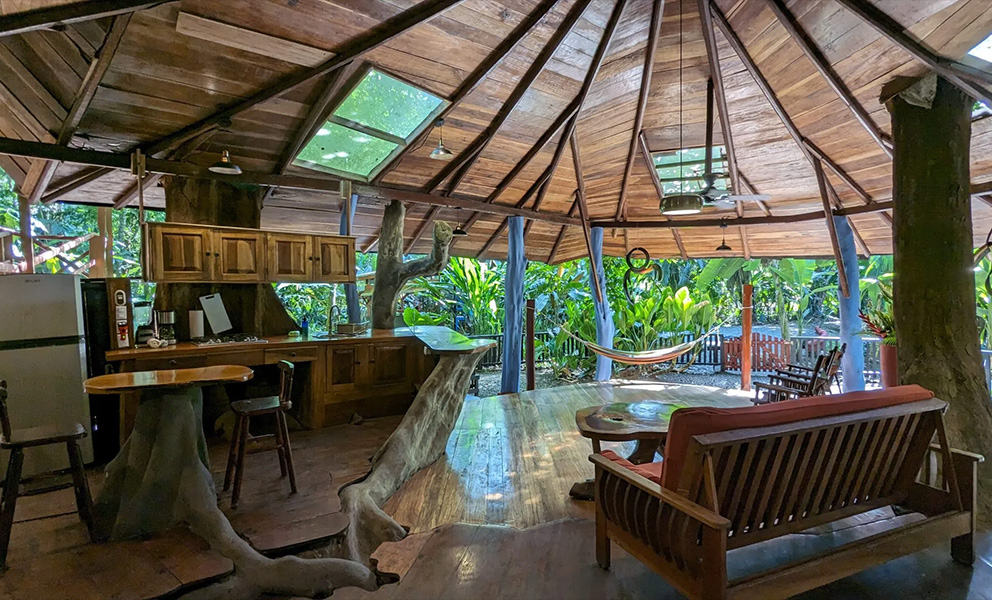Ask an expat hotel owner what it’s like starting a business in Costa Rica, and the answer is usually the same: unexpected costs, endless permit requirements and interminable delays. In other words, it sucks.
On a sunny morning in October, an expat hotel owner not only passed up the chance to complain, but offered a solution. “Here, it’s very convenient to have several projects,” said Edsart Besier, the Dutch owner of Tree House Lodge, an inspired ecolodge situated in Punta Uva on the Caribbean coast. “When one gets stuck and you’re waiting for a permit, you move on with another.”
Besier – who could pass for a mad scientist with his thick glasses and curly, seemingly electrified hair – was reclining in the living room of the first accommodation he built on the Tree House property, the eponymous “tree house.” The two-story marvel was built around several large trees, including a thick, 100-year-old sangrillo that rises through and wholly defines the downstairs bathroom.
“Usually people bulldoze first, then they design their house,” Besier said. “With my houses, I go the other way around. I integrate the nature.”
More than two decades ago, Besier came to Costa Rica for its nature, living first in Manzanillo and then in a school bus on what would eventually become his property in Punta Uva, which was mostly marshland back then. In 1999 he purchased 10 acres and started a project that began with one house and slowly grew into one of the most imaginative and ecofriendly lodges in the country.
First, he drained the swamp and planted tropical foliage throughout. Just for kicks, he built a shower into the side of the sangrillo tree, and covered its roots with a platform. When that went well, he decided to keep going, constructing a roof, an open-air living room and kitchen, and a second-story bedroom on stilts, accessible only by a hanging bridge.
As the years passed, Besier continued to get ideas for different types of houses, despite the fact that he had no previous experience with design or architecture.
“I just have a crazy mind,” he explained.
He dreamed up a garden house made entirely of bamboo, a dome-shaped beach house bathroom featuring colored skylights, and systems to heat and deliver rainwater via solar power and gravity. Recycling bins dot the property, and no insecticides or pesticides are used anywhere. Pretty unbelievable, considering the lack of walls.
When asked what kind of sorcery he’s using to keep away the critters, Besier politely explained (perhaps for the millionth time) that the breeze off the nearby stretch of beach keeps the mosquitoes away. He could not promise, however, that the occasional monkey, agouti, sloth or kinkajou would not wander into the kitchen, particularly if food was left out. But who would be upset about that?
Ensconced inside the Gandoca-Manzanillo National Refuge, Tree House Lodge’s private grounds are situated far enough away from civilization for honeymooners and families to enjoy their seclusion, but close enough to nearby towns to reach them via bicycle, available nearby for rent. Cruising past local health food shops, chocolate farms and craft stands, it’s amazing to think about how little things change in these laid-back beach hamlets – the area’s maritime zoning fiasco notwithstanding.
A little over a year ago, the Costa Rican government opted to enforce a largely ignored 1977 law that renders most of the development along the south Caribbean illegal, which has put something of a damper on construction.
Besier’s property is in a contested zone, but he isn’t too worried. Local leaders are fighting for the rights of the area’s longstanding business owners, and like always for Besier, the ideas keep coming.
Just a year and a half ago, he constructed a rancho for the tree house, featuring a breakfast area and a fire-warmed Jacuzzi, which he modeled after a similar tub he encountered in Holland. He liked it so much he built ranchos and tubs for the other three houses.
He’s also got Iguana Verde – an iguana restoration project – going, through which he’s raised hundreds of the reptiles and reintroduced them into the wild. Lately it’s been tough keeping the iguanas, though, he says, because local youth have discovered the farm, and sometimes they break in and steal the creatures for food.
It’s sad, but Besier’s got other projects, still. His latest brainchild is an organic farm up in the mountains, where he’s growing giant pumpkins, striped eggplants and some of the strangest cucumbers I have ever seen.
“Look at his,” he said, placing what he called a dragon egg into my hand. It was white and ovular, but when I took a bite, it was unmistakably a cucumber.
“Nobody’s ever seen that before,” Besier said. Then he gave me another one for the road.
Going There:
To get from San José to the Caribbean coast, take Highway 32 through Braulio Carrillo National Park, and then once you’ve reached Limón, head south for about an hour, until you reach Puerto Viejo. There, follow the paved road along the beach; Tree House Lodge Hotel is located 5 kilometers south, about a 20-minute drive, on the left. Look for the sign and the giant iguana on the gate. For more info, visit http://www.costaricatreehouse.com.






